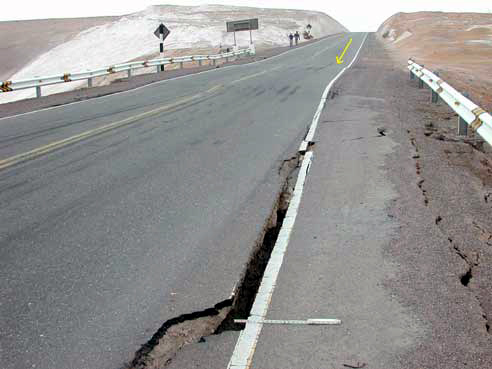Geotechnical Report from June 23, 2001 Peruvian Earthquake
4.0 GROUND FAILURE
Considerable damage occurred in the regions of Tacna, Moquegua, and Arequipa as a result of fill densification, liquefaction, landslides, and rockfalls. Ground failure was concentrated along Peruís primary north-south highway, the Pan-American highway, and several of the other major roads connecting the cities of Camana, Arequipa, Ilo, Moquegua, and Tacna. Several instances of relatively minor ground failure were also observed in urban centers of the region.
4.1 Fill Performance
Fill densification caused considerable damage to bridge abutments and approaches. Less severe, but nonetheless significant roadway damage occurred at the location of valley fills. The fill soils typically consisted of poorly graded coarse to fine sands, and non-plastic silts. The largest deformations were typically located along the edges of the roadways.

Figure 4.1: Fill densification occurred along many of the roadways in the regions of Tacna, Moquegua, and Arequipa. Damage was most pronounced at bridge abutments, where vertical displacements of 5 to 20 cm were common. The above photograph shows a bridge located between the towns of Tacna and Moquegua along the Pan-American highway [notes: (1) arrow shows location of vertical offset between bridge and adjacent roadway approach, (2) ruler shown in bottom of photograph is extended to 61 cm in length]
4.2 Liquefaction
Liquefaction occurred at three bridge sites located in alluvial valleys. In one instance, liquefaction-induced lateral spread severely damaged a concrete bridge and several residences located along the banks of the river. At another site, liquefaction caused a localized bearing capacity failure of a concrete column supporting a large, and relatively new bridge. A third site experienced about a meter of lateral spread, but no apparent damage to structures.

Figure 4.2: Liquefaction was observed at several bridge sites and along some of the river valleys. The photograph shown above was taken from the top of a river levee located near the Camiara Bridge. The offset in corn rows (left to right near middle of photograph) is due to localized lateral spread shear displacement. The area shown in the top portion of the photograph was retained by a bridge abutment (right of photograph, not shown) and generally remained stationary, while the ground in the bottom portion of the photograph moved approximately 2 meters toward the free face (i.e., toward the right).

Figure 4.3: Sand boils were found at all three of the liquefaction sites. Ejected soils were uniformly graded fine or medium sands. The ground opening shown above is approximately 30 cm in diameter.
4.3 Landslides
Landslides and slope stability failures occurred at localized cut and fill sections along highways. In most cases slope movements in the fill section were due to fill densification. The following pictures illustrate some of these cases.

Figure 4.4: Slope failures damaged many roadways in the affected regions. Damage was typically concentrated along the shoulders or edges of the roadways, although cracks often extended well beyond the top of the slope. The photograph shows a damaged portion of the Pan-American highway near the town of Tambillo.
4.4 Rockfall
Rockfall was observed along many of the near vertical road cuts in the region affected by the earthquake. The rockfall included individual blocks of rock to raveling of both bedrock and colluvial materials exposed in the road cuts. Some planar and wedge failures within the bedrock were also observed. Natural slopes composed of bedrock or colluvium had very little observed rockfall.

Figure 4.5: Large rock cut slope failure along highway between Moquegua and Cuajone.

Figure 4.6: Wedge failure of rock cut slope on Pan-American highway located south of Moquegua.

